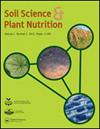中国北方封闭荒漠草原植被群落对土壤有机碳储量的影响
IF 1.8
4区 农林科学
Q3 ENVIRONMENTAL SCIENCES
引用次数: 3
摘要
封育是荒漠草原加强土壤固碳的有效措施。植物群落变化过程中土壤有机碳(SOC)及其储量影响土壤肥力和全球碳循环。研究了内蒙古荒漠草原6种植物群落类型土壤有机碳及其储量的变化。本研究的目的是在考虑环境因素影响的情况下,探讨不同植物群落土壤有机碳及其储量的差异。共采集了84个样地0 ~ 5 cm、5 ~ 10 cm、10 ~ 20 cm和20 ~ 30 cm 4种深度336份土壤样品和植被属性。结果表明,植物群落类型和土壤深度是影响根系生物量、有机碳和有机碳储量的主要因素。根系总生物量为229.21 ~ 731.71 g·m−2,排序为:鸡冠草>羊草>克氏针茅>蒙古葱>短花针茅>羊水旋花。鸡冠花伴生土壤的平均有机碳和碳储量分别是羊草伴生土壤的1.94倍和1.62倍。根系生物量、有机碳及其储量随土壤深度的增加而逐渐减少。不同植物群落土壤有机碳分层比(SR s)随土壤深度的增加而增加,土壤质量均较好(除羊草和蒙古沙外)。冗余分析(RDA)结果表明,根系生物量、粘土、盖度和凋落物生物量对土壤有机碳和土壤有机碳储量有显著影响。综上所述,封育后植物群落对土壤有机碳储量的改善作用最大,根系生物量对土壤有机碳储量的贡献最大。本文章由计算机程序翻译,如有差异,请以英文原文为准。
The effects of vegetation communities on soil organic carbon stock in an enclosed desert-steppe region of northern China
ABSTRACT Enclosure is an effective strategy for enhancing soil carbon sequestration in the desert steppe. Soil organic carbon (SOC) and its stock during changes in the plant community influence soil fertility and the global carbon cycle. We studied changes in SOC and its stock along with six plant community types in the desert steppe of Inner Mongolia, northern China. The goal of this study was to explore differences in SOC and its stock among plant communities while accounting for the effects of environmental factors. We collected 336 soil samples at four soil depths (0–5 cm, 5–10 cm, 10–20 cm, and 20–30 cm) and vegetation attributes from 84 plots in the enclosure. The results revealed that plant community type and soil depth were the most influential factors for root biomass, SOC, and SOC stock. Total root biomass varied from 229.21 to 731.71 g·m−2 and was ranked as follows: Koeleria cristata > Leymus chinensis > Stipa krylovii >Allium mongolicum >Stipa breviflora > Convolvulus ammannii. Mean SOC and its stock of soils associated with K. cristata were 1.94 and 1.62 times higher than that measured for C. ammannii soils, respectively. Root biomass, SOC, and its stock gradually decreased with soil depth. Stratification ratios (SR s) of SOC increased with soil depth for different plant communities and showed better soil quality (except C. ammannii and A. mongolicum). Results from redundancy analysis (RDA) showed that root biomass, clay, coverage, and litter biomass had significant impacts on SOC and SOC stock. We conclude that the plant community had the greatest effect on improving SOC stock after enclosure, and plant root biomass contributed the most to SOC stock.
求助全文
通过发布文献求助,成功后即可免费获取论文全文。
去求助
来源期刊

Soil Science and Plant Nutrition
农林科学-农艺学
CiteScore
4.80
自引率
15.00%
发文量
56
审稿时长
18-36 weeks
期刊介绍:
Soil Science and Plant Nutrition is the official English journal of the Japanese Society of Soil Science and Plant Nutrition (JSSSPN), and publishes original research and reviews in soil physics, chemistry and mineralogy; soil biology; plant nutrition; soil genesis, classification and survey; soil fertility; fertilizers and soil amendments; environment; socio cultural soil science. The Journal publishes full length papers, short papers, and reviews.
 求助内容:
求助内容: 应助结果提醒方式:
应助结果提醒方式:


